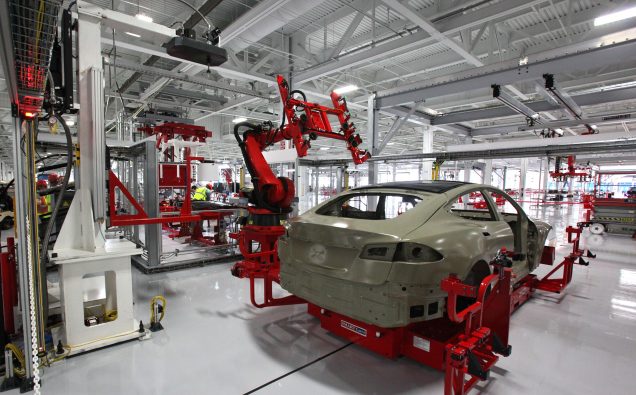
Featured Image shows manufacturing at Tesla Automobile Plant, Photo by Steve Jurvetson via Wikimedia Commons
The Trump Administration’s emphasis on making America a magnet of manufacturing and bringing jobs back to the United States has provoked a mixed response – from optimism among his supporters to caution among strategists, from immediate gains to the risk of overlooking other challenges facing the world’s largest economy.
Meanwhile, President Trump’s commitment to pursue infrastructure revamping projects, tax reform and fixing regulation measures have also seen the stock market rocketing to record highs.
But, according to a think tank report, a sustainable manufacturing boost is not so simple as it may seem, and is inextricably linked with a range of other economic dynamics that together would ultimately determine the health of the American economy.
The U.S. economy has many dimensions like relations with China, globalization or now perhaps a spate of setbacks to globalization, trade with regions and nations, where it must also advance foreign policy goals.
Among such factors would be the U.S. ability to fix its trade deficit and bolster trade competitiveness at home.
Information Technology and Innovation Foundation, a think tank, studied the issue in a recent comprehensive analysis. One of the challenges, for example, will be how to understand and practically approach the issue of manufacturing jobs at home and offshoring of jobs.
Between 2000 and 2016, the tech think tank says, the United States lost 29 percent of its manufacturing jobs, while total U.S. employment grew almost 10 percent, according the statistics cited by the think tank.
“That’s a delta of almost 40 percentage points. If the majority of these losses were due to automation, as is commonly stated, then enacting incentives to limit offshoring and getting tougher with America’s trading partners would be a response in search of a problem.”
A recent ITIF brief emphasizes that “an effective U.S. manufacturing policy needs to get the tactics, policies, and programs right—including reducing the effective tax rate on traded-sector firms, rolling back foreign mercantilist practices, and expanding Export-Import Bank authorization, the MEP program, and the Manufacturing USA program.”
It outlines 10 key principles to guide a Trump administration manufacturing policy, arguing that “the likelihood that individual steps will be implemented and succeed increases considerably if the overarching strategic issues are correctly identified, framed, and followed.”
While pointing to opportunities and challenges, the brief notes that the Trump Administration faces, saying the question of what an intelligent U.S. manufacturing strategy should entail is central to the future of the U.S. economy, “so getting it right is critical.”
“The Trump administration has a real opportunity to do that by ignoring both supercilious criticism and tired laissez faire thinking, but it also runs the risk of overreacting and thereby making things worse, not better.”
The think tank focuses on four key areas of debate, explaining some probing questions: why the U.S jobs were lost; why jobs went offshore; what’s the right amount of manufacturing for America; and whether manufacturing can return.
While the debate continues on the way forward for Washington, there is no specific agreement among economists as to what it should look like under an administration that has vowed to implement an American First policy, focus domestically, and not allow compromises with external factors at the cost of American workers’ well being.
Here is a set of ten strategic principles that the ITIF brief says should guide the administration’s efforts to restore U.S. manufacturing:
1. Focus on traded sectors, not just manufacturing;
2. Focus on high-value-added, defensible sectors and segments;
3. Focus on the trade deficit, not jobs per se;
4. Recognize what should stay and what shouldn’t;
5. Understand that when U.S. companies succeed in overseas markets it can help U.S. employment;
6. Focus on attraction rather than compulsion;
7. Move beyond one-off deals and a low-cost business climate;
8. Change the playing field through technology;
9. Support the defense industrial base; and
10. Pay attention to where advanced production is located in the United States.











